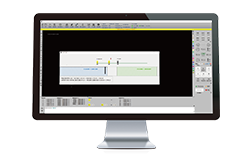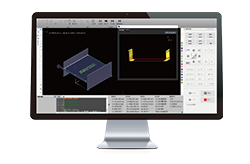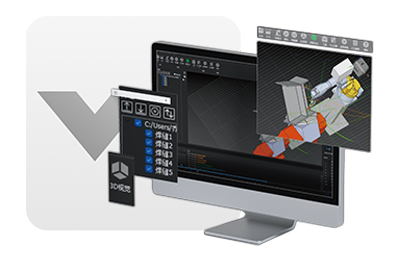-
Products
Overview Products
-
2D Cutting
-
Tube Cutting
-
3D Cutting
-
Intelligent Welding
-
Intelligent Cutting Head
-
Industrial Automation
-
Industrial Software
-
Combination
-
Combination
BOCHU New Product -
Combination
BOCHU New Product -
Controller
BOCHU New Product -
2D Cutting Head
Tube Cutting Head
3D Cutting Head
Consumables
BOCHU New Product -
Servo
BOCHU New Product -
Industrial 4.0
-
- Support
- About
- Online Store


- Software Download
- Manual
- Video
- Tutorial
I. Introduction
When cutting the web of H-beams or bevels of arbitrary cross-sectional profiles, the cutting head will oscillate. Since the cutting head itself has a certain physical volume, it is highly likely to interfere with the workpiece when oscillating.
To ensure safer machining, The Collision-Avoid function (formerly known as Vector Modify) must be used for bevel toolpaths. This function will perform interference detection based on the volume of the cutting head and the oscillation angle, automatically modifying angles that may cause collisions to a safe position.
II. How to Use
1. Permission related
Since version 7.1.57, the 【Contour Vector】has been upgraded to【Vector Modify】, and the cutting head models have been upgraded. Since version 2025v2, the 【Vector Modify】feature has been replaced by the【Collision-Avoid 】feature for better understanding.
Version before 2025v2
Version 2025v2 and later
Starting from version 7.1.57, the cutting head model has also been upgraded from 2D model in chc format to 3D model in ses.
If you want to use the above function, please check your version number first, if it is a low version, you can click here to upgrade the nesting software.
Because of the upgraded Collision-Avoid function, starting from version 7.1.57, TubesT supports cutting H-steel web bevel toolpath.
Supplementary: Turn on 【Collision Check】 in the User Preference (Settings), you can automatically perform anti-collision detection during【Simulation】. If there is a risk of head collision there will be a pop-up window to remind; if not collision will be prompted in the log that the interference detection passed.
2. Laser Head Module
| Category | File Format | Purpose | How to Obtain the Model |
| 2D Cutting Head | chc format |
Automatic collision detection for contour vectors of H-beams and special-shaped tubes Only detects interference caused by B-axis rotation cannot detect bevel toolpaths |
Refer to the guide on How to configure the chc cutting head file |
| 3D Cutting Head | ses format |
Supports automatic collision detection for both contour vectors and bevel vectors of H-beams and special-shaped tubes Can detect interference caused by A-axis and B-axis rotation can detect bevel toolpaths (except for H-beam flanges) |
Contact the equipment manufacturer to create an ses format 3D cutting head model Note: Only BLT cutting heads can be configured |
When using a beveling machine, always select the SES model for bevel cuts. For non-beveling machines or when SES is unavailable, you can use the CHC model.
Note: Whether it is a chc or ses model, ensurng the cutting head model in software matches the physical machine configuration. Never arbitrarily select a cutting head.
3. Collison-Avoid
For I-beam parts, after checking and confirming that the shape of the parts in the software is consistent with the drawings, first do 【Collision Avoid】, and then carry out operations such as Optimize H-beam Web Toolpath, Kerf Compensation(fixed height), and Nest.
For other parts, after importing the parts, after identifying/adding bevels and other processes, click on 【Collision Avoid】 for automatic modification, and then carry out operations such as Nest.
Parameters can be kept as default and click OK.
If you don't cut a bevel, use a chc or ses model, the bump pass will prompt:
If your drawing has a bevel, but you are using a chc 2D cutting head, the software will prompt you that it is currently a 2D cutting head and does not support the detection of the bevel toolpath:
If it is an I-beam part, you can click 【Cancel Bevel at H-Beam Web】 and then try Collision Avoid again.
If it is other parts, you can use 【Normal Vector Error Detection】to judge by yourself whether there will be interference or click 【Cancel Bevel]】+ 【Manually Modify Contour Vector】, which will be displayed after the detection passes:
Or click 【Simulation】 to observe by yourself whether there will be collision.
If the collision avoidance does not pass, it will be indicated as below, with a pop-up window, an exclamation point in the part list, and the part body marked in red:
At this time you can:
Adjust the parameters: for example, reduce the offset distance, cutting head allowance, following height.
If the I-beam R angle near the modification failed, check whether the R angle and whether and the actual pipe to maintain consistency, in line with the basis of the r angle will be adjusted larger 2-3mm.
Manual adjustment to see whether the size of the part and the cutting head is geometrically certain to maintain the interference, can not be cut. Tutorial →【Manually Modify Contour Vector】
IⅢ. FAQS
- How to import a newly configured ses model?
- What is the meaning of each parameter in 【Collision Avoid】?
Follow height: Distance between the cutting head and the plate surface.
Safety margin: The 1mm Safety margin rule applies differently per model.
① Chc format: Expands both sides of the model by 1mm for collision avoidance.
② Ses format: Maintains ≥1mm gap between cutting head (excluding nozzle) and part geometry.
Offset distance (i.e. Tilt Distance): Distance the node allowed to move from the interference area towards the non-interference area (if modification fails, try reducing this value).
-
- Application Range
- Active section set: Applies to all parts within the selected section group in the main interface.
- All section sets: Applies to all parts in the part list.
- Application Range
- What is the principle of 【Collision Avoid】modification?
No interference as much as possible.
For parts with tongue shape, we will make sure that the maximum size of the tongue is the same as the drawing.
*If there are very few parts and the modification is very slow, please give feedback to the customer service staff in the technical exchange group.
- How to automatically perform Collision Avoid at 【Simulation】?
At the User Preference /User Setting (pinion button), turn on 【Collision Check】, and the cutting head will automatically perform path anti-collision when the simulation button is clicked.
I. Introduction
When cutting the web of H-beams or bevels of arbitrary cross-sectional profiles, the cutting head will oscillate. Since the cutting head itself has a certain physical volume, it is highly likely to interfere with the workpiece when oscillating.
To ensure safer machining, The Collision-Avoid function (formerly known as Vector Modify) must be used for bevel toolpaths. This function will perform interference detection based on the volume of the cutting head and the oscillation angle, automatically modifying angles that may cause collisions to a safe position.
II. How to Use
1. Permission related
Since version 7.1.57, the 【Contour Vector】has been upgraded to【Vector Modify】, and the cutting head models have been upgraded. Since version 2025v2, the 【Vector Modify】feature has been replaced by the【Collision-Avoid 】feature for better understanding.
Version before 2025v2
Version 2025v2 and later
Starting from version 7.1.57, the cutting head model has also been upgraded from 2D model in chc format to 3D model in ses.
If you want to use the above function, please check your version number first, if it is a low version, you can click here to upgrade the nesting software.
Because of the upgraded Collision-Avoid function, starting from version 7.1.57, TubesT supports cutting H-steel web bevel toolpath.
Supplementary: Turn on 【Collision Check】 in the User Preference (Settings), you can automatically perform anti-collision detection during【Simulation】. If there is a risk of head collision there will be a pop-up window to remind; if not collision will be prompted in the log that the interference detection passed.
2. Laser Head Module
| Category | File Format | Purpose | How to Obtain the Model |
| 2D Cutting Head | chc format |
Automatic collision detection for contour vectors of H-beams and special-shaped tubes Only detects interference caused by B-axis rotation cannot detect bevel toolpaths |
Refer to the guide on How to configure the chc cutting head file |
| 3D Cutting Head | ses format |
Supports automatic collision detection for both contour vectors and bevel vectors of H-beams and special-shaped tubes Can detect interference caused by A-axis and B-axis rotation can detect bevel toolpaths (except for H-beam flanges) |
Contact the equipment manufacturer to create an ses format 3D cutting head model Note: Only BLT cutting heads can be configured |
When using a beveling machine, always select the SES model for bevel cuts. For non-beveling machines or when SES is unavailable, you can use the CHC model.
Note: Whether it is a chc or ses model, ensurng the cutting head model in software matches the physical machine configuration. Never arbitrarily select a cutting head.
3. Collison-Avoid
For I-beam parts, after checking and confirming that the shape of the parts in the software is consistent with the drawings, first do 【Collision Avoid】, and then carry out operations such as Optimize H-beam Web Toolpath, Kerf Compensation(fixed height), and Nest.
For other parts, after importing the parts, after identifying/adding bevels and other processes, click on 【Collision Avoid】 for automatic modification, and then carry out operations such as Nest.
Parameters can be kept as default and click OK.
If you don't cut a bevel, use a chc or ses model, the bump pass will prompt:
If your drawing has a bevel, but you are using a chc 2D cutting head, the software will prompt you that it is currently a 2D cutting head and does not support the detection of the bevel toolpath:
If it is an I-beam part, you can click 【Cancel Bevel at H-Beam Web】 and then try Collision Avoid again.
If it is other parts, you can use 【Normal Vector Error Detection】to judge by yourself whether there will be interference or click 【Cancel Bevel]】+ 【Manually Modify Contour Vector】, which will be displayed after the detection passes:
Or click 【Simulation】 to observe by yourself whether there will be collision.
If the collision avoidance does not pass, it will be indicated as below, with a pop-up window, an exclamation point in the part list, and the part body marked in red:
At this time you can:
Adjust the parameters: for example, reduce the offset distance, cutting head allowance, following height.
If the I-beam R angle near the modification failed, check whether the R angle and whether and the actual pipe to maintain consistency, in line with the basis of the r angle will be adjusted larger 2-3mm.
Manual adjustment to see whether the size of the part and the cutting head is geometrically certain to maintain the interference, can not be cut. Tutorial →【Manually Modify Contour Vector】
IⅢ. FAQS
- How to import a newly configured ses model?
- What is the meaning of each parameter in 【Collision Avoid】?
Follow height: Distance between the cutting head and the plate surface.
Safety margin: The 1mm Safety margin rule applies differently per model.
① Chc format: Expands both sides of the model by 1mm for collision avoidance.
② Ses format: Maintains ≥1mm gap between cutting head (excluding nozzle) and part geometry.
Offset distance (i.e. Tilt Distance): Distance the node allowed to move from the interference area towards the non-interference area (if modification fails, try reducing this value).
-
- Application Range
- Active section set: Applies to all parts within the selected section group in the main interface.
- All section sets: Applies to all parts in the part list.
- Application Range
- What is the principle of 【Collision Avoid】modification?
No interference as much as possible.
For parts with tongue shape, we will make sure that the maximum size of the tongue is the same as the drawing.
*If there are very few parts and the modification is very slow, please give feedback to the customer service staff in the technical exchange group.
- How to automatically perform Collision Avoid at 【Simulation】?
At the User Preference /User Setting (pinion button), turn on 【Collision Check】, and the cutting head will automatically perform path anti-collision when the simulation button is clicked.
























